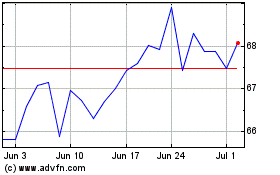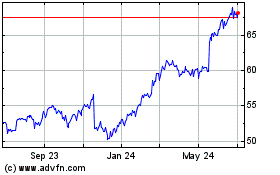Don't Be Spooked by Walmart's Rising Costs
May 19 2020 - 1:25PM
Dow Jones News
By Jinjoo Lee
Walmart tries to live by its twin mottoes of Everyday Low Prices
and Everyday Low Costs. The latter has been a challenge, but
investors should take it in stride.
The retailer reported Tuesday that total revenue jumped to
$134.6 billion for the fiscal first quarter, which ended April 30
-- an 8.6% increase compared with a year earlier. Both its top and
bottom lines exceeded analysts' expectations. Of particular note
was Walmart's e-commerce sales, which grew by 74% year-over-year --
a substantial acceleration from the previous quarter's pace of 35%.
Walmart shares gave back early gains to rise only modestly by
midday, though.
Investors might be wary of Walmart's cost of sales, which grew
9.7%, also topping estimates and putting a damper on operating
income growth. Walmart said Covid-19 related costs -- increased
wages, benefits and heightened sanitation measures -- added up to
nearly $900 million during the quarter. The shift to e-commerce
already had been a drag on profitability even before the pandemic.
The company also said gross margins were negatively affected by a
shift to sales in lower-margin categories such as groceries and
consumables.
One obvious solution to the margin problem is to simply sell
more, as Walmart U.S. Chief Executive Officer John Furner pointed
out on the retailer's last earnings call. Revenue was on a steady
growth trajectory well before the pandemic; the sudden e-commerce
boost is already having an effect on operating income, which grew
by 5.6% in the first quarter compared with a year earlier after the
previous quarter saw a 12.3% year-over-year drop. Evercore ISI
estimates that Walmart's operating margin will rise in the next two
to four years as grocery pickup turns profitable.
Since mid-March there has been a fourfold increase in new
customers for pickup and delivery, and Walmart has seen indications
that those customers are returning. A customer who shops in both
the physical store and through the Walmart app or website spends
twice as much as a customer who shops in stores only, the company
said during its last earnings call.
Walmart's in-person experience also seems relatively
well-positioned to thrive in a low-contact world. Its supercenters,
many of which are open 24 hours and average 178,000 square feet,
might reassure customers skittish about keeping a safe distance
from others.
Some of Walmart's added costs will bleed into coming quarters.
It already announced a second round of associate bonuses, which
will affect second quarter results. But the rush of new customers
should go a long way toward offsetting those costs in the long run
as the company makes more higher-margin goods available for pickup
and delivery.
Much of this already is priced into Walmart's shares, which last
month reached an all-time high and have outpaced the broad U.S.
market by 17 percentage points this year. Tuesday's lukewarm
response to a solid beat shows some skepticism about its ability to
keep growing its top line quickly enough to deal with the rising
cost of doing business after the rush of pandemic business
fades.
Investors should have more faith.
(END) Dow Jones Newswires
May 19, 2020 13:10 ET (17:10 GMT)
Copyright (c) 2020 Dow Jones & Company, Inc.
Walmart (NYSE:WMT)
Historical Stock Chart
From Mar 2024 to Apr 2024

Walmart (NYSE:WMT)
Historical Stock Chart
From Apr 2023 to Apr 2024
